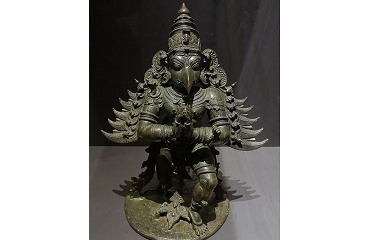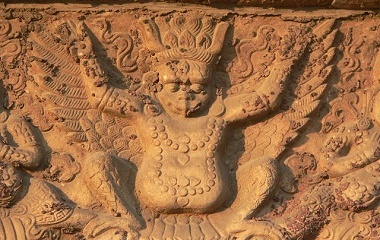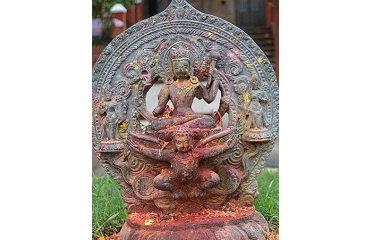Who is Garuda?
Garuda is an immortal bird-god, beloved by Hindus and Buddhists alike. This golden character is so mighty, he has been known to exterminate entire oceans full of snakes and to defeat entire armies of gods in one battle. Fortunately, he fights on the side of the righteous—most of the time!
Characteristics
Physical Description
With nicknames like “king of the birds” and “he who has beautiful feathers,” Garuda is bound to be a glorious sight.
According to Hind tradition, he has the torso and arms of a strong man with golden skin. Red wings with long, glimmering feathers spread from behind his back and stretch up to a mile wide. Beneath the knee, his legs are covered with golden scales that lead down to eagle’s feet with talons like curved daggers. His face is white and can be completely human, human with a beak, or completely eagle. A traditional Hindu crown with several golden tiers sits on top of his head, and he wears snakes that he has defeated in battle as jewelry. Altogether, he is large enough to block out the sun when he flies by it. The “supreme god” Vishnu can often be seen riding on his back.
In Hindu art, Garuda has evolved over centuries to look more human. In Nepal, he is often depicted as a human with wings. In the rest of Asia, he has maintained his bird’s head, beak, and talons. Indonesia’s version of Garudas is especially colorful and is depicted with tusks.
In Bhuddist art, the god Garuda has been transformed into a race of noble birds, called “garudas.” These garudas are the least human of all. Their bodies are covered in feathers, and their wings seem to be attached to their arms, almost like a bat. Only their round bellies and human hands suggest their human-lineage.
Personality
In Hindu lore, Garuda represents heavenly power. On the bright side, he is a symbol of virtue, hope, and rebirth—but he has his dark side too. Garuda is a brilliant warrior, and while it’s true that his enemies, the naga serpents, are agents of the underworld, it’s also true that he shows no mercy in his attacks. Therefore, he symbolizes speed, violence, and military prowess as much as he does virtue, hope, and rebirth.
Bhuddist lore lists the Garuda as one of the “Four Dignities”—animals that represent Bhuddist virtues. The Four Dignities are the dragon representing power; the tiger, representing confidence; the snow leopard, representing fearlessness; and the Garuda, representing wisdom.
Special Abilities
Garuda’s dazzling debut in Hindu legend made his potential clear from the start. He burst forth from his egg in a fiery inferno, so large that it could have burnt the whole world to a crisp, had the gods not fallen to their knees and begged for mercy. The baby Garuda heard their pleas and responded with yet another display of magical power: he shrank himself down to a safe size.
Over time, Garuda would use his shrinking/growing trick to carry out various heroic tasks. He once defeated all the other gods in battle by growing to such a huge size that the wind from his wings scattered them across the world. He also used his super-size to swallow entire rivers and oceans, either to use the water as a weapon or to find snakes who were hiding in the water. He could cause mountains to collapse or thunderstorms to sweep across the land just by flapping his wings. And don’t forget—he could shrink too, which meant that he could always find a crack to escape through or a hole to hide in.
Conveniently, Garuda was also immune to the venom of his arch enemies, the snakes. Talismans with his image and prayers with his name could also be used to protect mortals from the effects of any poison.
Cultural Representation
Origin
Garuda first appears in the Hindu Vedas, written between 1500 and 400 BCE, but the longest story about him comes out in the Mahabharata, an epic poem written around 400 BCE. His fame spread rapidly throughout Asia; ancient statues and paintings of him can be found in India, Indonesia, Japan, Mongolia, Nepal, Suriname, the Philippines, and Thailand.
Eventually, Garuda was absorbed by the Buddhist faith. He first appears in the Maha-samaya Sutta, one of the earliest ritual prayers to be recited by Bhuddists.
Modern Appearances
While Garuda hasn’t made a big splash in western culture, he is still a beloved character in many nations that practice Hindu or Buddhism. He can be found on temples, in prayers, and in ritual dances. He also appears in the secular arena, with countless military aircrafts and sport teams named after him. Thailand and Indonesia have even gone so far as to declare Garuda their “national symbol.”










